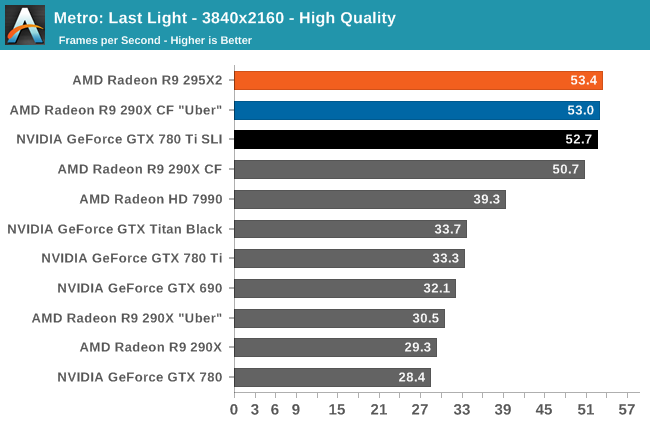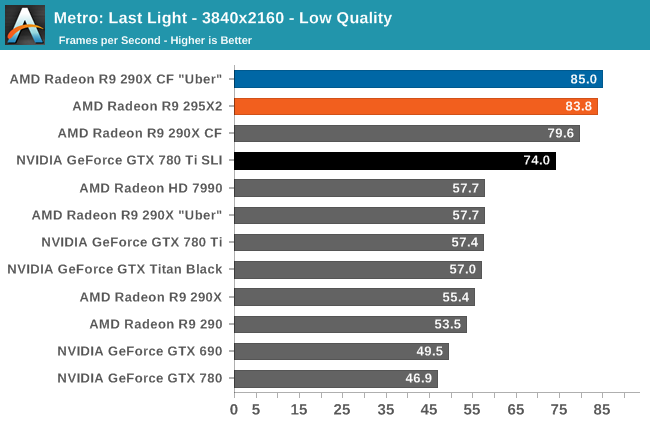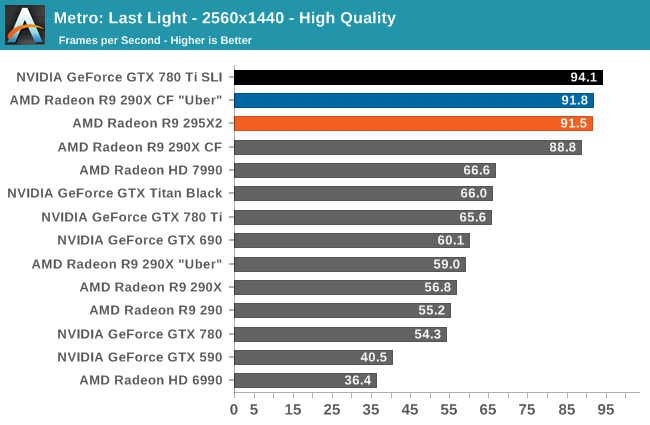The AMD Radeon R9 295X2 Review
by Ryan Smith on April 8, 2014 8:00 AM EST- Posted in
- GPUs
- AMD
- Radeon
- Radeon 200
Metro: Last Light
As always, kicking off our look at performance is 4A Games’ latest entry in their Metro series of subterranean shooters, Metro: Last Light. The original Metro: 2033 was a graphically punishing game for its time and Metro: Last Light is in its own right too. On the other hand it scales well with resolution and quality settings, so it’s still playable on lower end hardware.



Our first gaming benchmark pretty much sets the tone for what we’ll be seeing in this review. In building the 295X2 AMD set out to build a single card that could match the performance of the 290X “Uber” In Crossfire, and that is exactly what we see happening here. The 295X2 and 290XU CF swap places due to run-to-run variation, but ultimately both tie together, whether it’s above the GTX 780 Ti SLI or below it.
As we’ve already seen with the 290X, thanks in part to AMD’s ROP advantage, AMD’s strong suit is in very high resolutions. This leads to the 295X2 edging out the competition at 2160p, while being edged out itself at 1440p. None the less between AMD and NVIDIA setups this is a very close fight thus far, and will be throughout. As for Metro, even at the punishing resolution of 2160, the 295X2 is fast enough to keep this game going at above 50fps.










131 Comments
View All Comments
Kevin G - Tuesday, April 8, 2014 - link
Typo:"The PCB itself is 14 layers, making it an especially intricate PCB, but one necessary to carry 500W while also routing 1028 GDDR5 lines and 48 PCIe 3 lanes."
I presume 1028 is actually representative of the combined 1024 bit wide memory bus.
Ryan Smith - Tuesday, April 8, 2014 - link
Noted and fixed. Thank you.CiccioB - Tuesday, April 8, 2014 - link
Isn't 500W from 2x8 + PCI-E out of standards and connctor specifics and somewhat dangerous?ShieTar - Tuesday, April 8, 2014 - link
Its out of spec, as also discussed in the article, but very unlikely to be dangerous. 215W at 12V over 3 wires will draw about 6A per wire, still significantly below what the ATX standard considers safe:"Under normal or overload conditions, no output shall continuously provide more than 240 VA".
The interesting question will be if the PSUs are up to the task of filtering the rapid switching between almost 0W and up to 425W on the rail which feeds the two connectors. But most modern, high power PSUs feed even more connectors on a single rail, so they should have little problem. And whoever mates a 1500$ GPU with a cheap PSU has nobody to blame but himself.
LoccOtHaN - Tuesday, April 8, 2014 - link
Really fine Card for 4k gaming. Nice Job AMD/ATI and 1498$ is not expensive for Entusiast Level of Hardware. NICECiccioB - Tuesday, April 8, 2014 - link
Broken frame pacing does not really put this card as the best choice for playing, IMHO.LasseGrr - Tuesday, April 8, 2014 - link
@CiccioB Maybe try reading the article again...CiccioB - Tuesday, April 8, 2014 - link
You may look at those frame per seconds graphs more closely. When provided, those graphs do not show good frame pacing timings, and where not provided, look to other site's reviews.But then, I'm sure who ever spend $1500 for a gaming card has all the reason to convince himself that the card is good nonetheless.
extide - Tuesday, April 8, 2014 - link
What are you talking about?? First of all, an FPS graph shows NOTHING about frame timing variance.Second of all, they DO specifically show the frame timing, in different graphs, and it is fine, very similar to nVidia's results!
Are you not able to read or something?!
CiccioB - Wednesday, April 9, 2014 - link
Sorry, but what kind of graph are you looking at?First, not all reviewed games here have a frame pacing graph.
Second, look at BF4, Crysis3, Thief graphs for example. Where do you see this card being better than a SLI of 780Ti?
The FPS graphs are a mess for this 295x2. Ideally those graphs should be a thin line, not an area where the frame per seconds continously oscillate.
But, well, as said, once you spend (or want to spend) $1500 you have to convince yourself there are no problems. The same was true for 7990 buyers that glorified that card. See now what a crappy card it is. And that was also true for all those that negated that AMD Crossfire configurations had problem with respect to nvidia ones before AMD tried to correct the problem with new drivers (that somewhat now work for DX11 games but not with DX9 and 10 ones, and that's maybe the reason that for older games there's not the frame pacing graphs...).